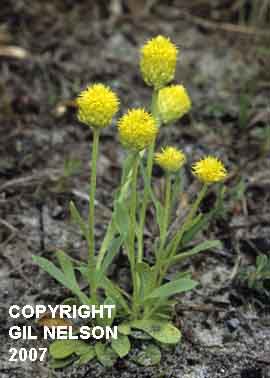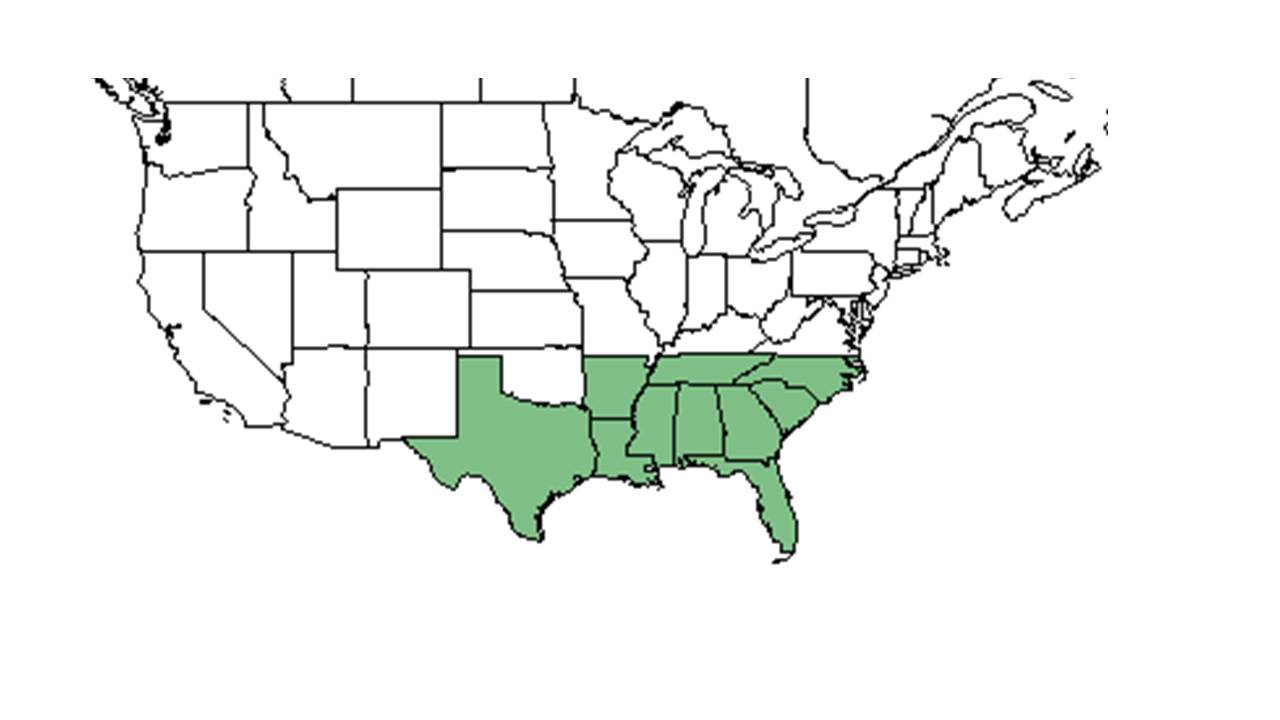Difference between revisions of "Polygala nana"
(→Taxonomic notes) |
|||
| (10 intermediate revisions by 6 users not shown) | |||
| Line 18: | Line 18: | ||
}} | }} | ||
| − | Common names: | + | Common names: candyroot, dwarf milkwort |
==Taxonomic notes== | ==Taxonomic notes== | ||
| − | Synonyms: ''Pilostaxis nana'' (Michaux) Rafinesque; ''Pylostachya nana'' (Michaux) Rafinesque | + | Synonyms: ''Pilostaxis nana'' (Michaux) Rafinesque; ''Pylostachya nana'' (Michaux) Rafinesque<ref name=weakley>Weakley, A.S. 2020. Flora of the Southeastern United States. Edition of 20 October 2020. University of North Carolina at Chapel Hill, Chapel Hill, North Carolina.</ref> |
| + | |||
| + | Varieties: none<ref name=weakley/> | ||
==Description== | ==Description== | ||
<!-- Basic life history facts such as annual/perrenial, monoecious/dioecious, root morphology, seed type, etc. --> | <!-- Basic life history facts such as annual/perrenial, monoecious/dioecious, root morphology, seed type, etc. --> | ||
| − | "Herbs, whorled or alternate rarely opposite, entire leaves. Flowers lavender, pink, white or yellow, in racemes or spikes, terminating the branches or in terminal corymbs. Flowers perfect, zygomorphic, with 3 small sepals, frequently one of these slightly larger than the others, and 2 larger petaloid sepals (wigs). The 3 petals are united into a tube, 3-lobed at apex, the 2 lateral lobes usually the longer, the center lobe usually lacerate, often thicker in texture; stamens 6-8, united to the corolla tube in 2 rows. Capsule 2 –locular, with one seed in each locule. Seeds dark brown or black, ellipsoid or ovoid, rarely globose, 0.5-3 mm long, usually densely pubescent. The genus has been divided into several genera none of which have distinct characteristics. Orange flowers turn pale yellow on drying, yellow ones bluish green; the pink or lavender ones remain the same color or fade slightly." <ref name="Radford"> Radford, Albert E., Harry E. Ahles, and C. Ritchie Bell. Manual of the Vascular Flora of the Carolinas. 1964, 1968. The University of North Carolina Press. 660. Print. </ref> | + | "Herbs, whorled or alternate rarely opposite, entire leaves. Flowers lavender, pink, white or yellow, in racemes or spikes, terminating the branches or in terminal corymbs. Flowers perfect, zygomorphic, with 3 small sepals, frequently one of these slightly larger than the others, and 2 larger petaloid sepals (wigs). The 3 petals are united into a tube, 3-lobed at apex, the 2 lateral lobes usually the longer, the center lobe usually lacerate, often thicker in texture; stamens 6-8, united to the corolla tube in 2 rows. Capsule 2 –locular, with one seed in each locule. Seeds dark brown or black, ellipsoid or ovoid, rarely globose, 0.5-3 mm long, usually densely pubescent. The genus has been divided into several genera none of which have distinct characteristics. Orange flowers turn pale yellow on drying, yellow ones bluish green; the pink or lavender ones remain the same color or fade slightly."<ref name="Radford"> Radford, Albert E., Harry E. Ahles, and C. Ritchie Bell. Manual of the Vascular Flora of the Carolinas. 1964, 1968. The University of North Carolina Press. 660. Print. </ref> |
| − | "Similar to ''P. lutea''. 3-15 cm tall, with leaves mostly confined to a basal rosette; stem leaves few. Flowers lemon yellow. Wings 7-8 mm long, long acuminate." <ref name="Radford"/> | + | "Similar to ''P. lutea''. 3-15 cm tall, with leaves mostly confined to a basal rosette; stem leaves few. Flowers lemon yellow. Wings 7-8 mm long, long acuminate."<ref name="Radford"/> |
==Distribution== | ==Distribution== | ||
==Ecology== | ==Ecology== | ||
===Habitat=== <!--Natural communities, human disturbed habitats, topography, hydrology, soils, light, fire regime requirements for removal of competition, etc.--> | ===Habitat=== <!--Natural communities, human disturbed habitats, topography, hydrology, soils, light, fire regime requirements for removal of competition, etc.--> | ||
| − | This species has been found in open, well-drained wiregrass-pine flatwoods and interdune swales growing on both dry and moist sands. <ref name="FSU Herbarium">Florida State University Robert K. Godfrey Herbarium database. URL: [http://herbarium.bio.fsu.edu http://herbarium.bio.fsu.edu]. Last accessed: July 2015. Collectors: : Loran C. Anderson, Leon Neel, R. A. Norris, Robert K. Godfrey, Walter Kittredge, R. Komarek, Lisa Keppner. States and Counties: Florida: Franklin, Gadsden, Leon, Wakulla, Washington. Georgia: Grady, Thomas. Compiled by Tall Timbers Research Station and Land Conservancy.</ref> Observed species in sandhill longleaf pine habitat that has 1 to 3 year fire return intervals. Also seen near a cypress pond, about 1 to 2 feet from water’s edge of Pebble Hill Plantation C plots. (Michelle M. Smith – early summer 2014 and 2015).''P. nana'' has also been found growing along the sides of highways and in the wetlands of clear cut areas. <ref name="FSU Herbarium"/> Associated species include ''Pinus palustris'' and ''Aristida stricta.'' <ref name="FSU Herbarium"/> | + | This species has been found in open, well-drained wiregrass-pine flatwoods and interdune swales growing on both dry and moist sands.<ref name="FSU Herbarium">Florida State University Robert K. Godfrey Herbarium database. URL: [http://herbarium.bio.fsu.edu http://herbarium.bio.fsu.edu]. Last accessed: July 2015. Collectors: : Loran C. Anderson, Leon Neel, R. A. Norris, Robert K. Godfrey, Walter Kittredge, R. Komarek, Lisa Keppner. States and Counties: Florida: Franklin, Gadsden, Leon, Wakulla, Washington. Georgia: Grady, Thomas. Compiled by Tall Timbers Research Station and Land Conservancy.</ref> Observed species in sandhill longleaf pine habitat that has 1 to 3 year fire return intervals. Also seen near a cypress pond, about 1 to 2 feet from water’s edge of Pebble Hill Plantation C plots. (Michelle M. Smith – early summer 2014 and 2015).''P. nana'' has also been found growing along the sides of highways and in the wetlands of clear cut areas.<ref name="FSU Herbarium"/> Associated species include ''Pinus palustris'' and ''Aristida stricta.''<ref name="FSU Herbarium"/> |
| + | |||
| + | ''Polygala nana'' is an indicator species for the Upper Panhandle Savannas community type as described in Carr et al. (2010).<ref>Carr, S.C., K.M. Robertson, and R.K. Peet. 2010. A vegetation classification of fire-dependent pinelands of Florida. Castanea 75:153-189.</ref> | ||
===Phenology=== <!--Timing off flowering, fruiting, seed dispersal, and environmental triggers. Cite PanFlora website if appropriate: http://www.gilnelson.com/PanFlora/ --> | ===Phenology=== <!--Timing off flowering, fruiting, seed dispersal, and environmental triggers. Cite PanFlora website if appropriate: http://www.gilnelson.com/PanFlora/ --> | ||
| Line 37: | Line 41: | ||
===Seed dispersal=== | ===Seed dispersal=== | ||
| − | This species is thought to be dispersed by ants and/or explosive dehiscence. <ref>Kirkman, L. Katherine. Unpublished database of seed dispersal mode of plants found in Coastal Plain longleaf pine-grasslands of the Jones Ecological Research Center, Georgia.</ref> | + | This species is thought to be dispersed by ants and/or explosive dehiscence.<ref>Kirkman, L. Katherine. Unpublished database of seed dispersal mode of plants found in Coastal Plain longleaf pine-grasslands of the Jones Ecological Research Center, Georgia.</ref> |
<!--===Seed bank and germination===--> | <!--===Seed bank and germination===--> | ||
| − | + | ||
| + | ===Fire ecology=== <!--Fire tolerance, fire dependence, adaptive fire responses--> | ||
| + | Populations of ''Polygala nana'' have been known to persist through repeated annual burns.<ref>Robertson, K.M. Unpublished data collected from Pebble Hill Fire Plots, Pebble Hill Plantation, Thomasville, Georgia.</ref><ref>Platt, W.J., R. Carter, G. Nelson, W. Baker, S. Hermann, J. Kane, L. Anderson, M. Smith, K. Robertson. 2021. Unpublished species list of Wade Tract old-growth longleaf pine savanna, Thomasville, Georgia.</ref> | ||
<!--===Pollination===--> | <!--===Pollination===--> | ||
| − | <!--=== | + | <!--===Herbivory and toxicology===<!--Common herbivores, granivory, insect hosting, poisonous chemicals, allelopathy, etc--> |
<!--===Diseases and parasites===--> | <!--===Diseases and parasites===--> | ||
| − | ==Conservation and | + | ==Conservation, cultivation, and restoration== |
| − | == | + | |
| + | ==Cultural use== | ||
==Photo Gallery== | ==Photo Gallery== | ||
<gallery widths=180px> | <gallery widths=180px> | ||
Latest revision as of 10:32, 14 July 2023
| Polygala nana | |
|---|---|

| |
| Photo taken by Gil Nelson | |
| Scientific classification | |
| Kingdom: | Plantae |
| Division: | Magnoliophyta – Flowering plants |
| Class: | Magnoliopsida – Dicotyledons |
| Order: | Polygalales |
| Family: | Polygalaceae |
| Genus: | Polygala |
| Species: | P. nana |
| Binomial name | |
| Polygala nana (Michx.) DC. | |

| |
| Natural range of Polygala nana from USDA NRCS Plants Database. | |
Common names: candyroot, dwarf milkwort
Contents
Taxonomic notes
Synonyms: Pilostaxis nana (Michaux) Rafinesque; Pylostachya nana (Michaux) Rafinesque[1]
Varieties: none[1]
Description
"Herbs, whorled or alternate rarely opposite, entire leaves. Flowers lavender, pink, white or yellow, in racemes or spikes, terminating the branches or in terminal corymbs. Flowers perfect, zygomorphic, with 3 small sepals, frequently one of these slightly larger than the others, and 2 larger petaloid sepals (wigs). The 3 petals are united into a tube, 3-lobed at apex, the 2 lateral lobes usually the longer, the center lobe usually lacerate, often thicker in texture; stamens 6-8, united to the corolla tube in 2 rows. Capsule 2 –locular, with one seed in each locule. Seeds dark brown or black, ellipsoid or ovoid, rarely globose, 0.5-3 mm long, usually densely pubescent. The genus has been divided into several genera none of which have distinct characteristics. Orange flowers turn pale yellow on drying, yellow ones bluish green; the pink or lavender ones remain the same color or fade slightly."[2]
"Similar to P. lutea. 3-15 cm tall, with leaves mostly confined to a basal rosette; stem leaves few. Flowers lemon yellow. Wings 7-8 mm long, long acuminate."[2]
Distribution
Ecology
Habitat
This species has been found in open, well-drained wiregrass-pine flatwoods and interdune swales growing on both dry and moist sands.[3] Observed species in sandhill longleaf pine habitat that has 1 to 3 year fire return intervals. Also seen near a cypress pond, about 1 to 2 feet from water’s edge of Pebble Hill Plantation C plots. (Michelle M. Smith – early summer 2014 and 2015).P. nana has also been found growing along the sides of highways and in the wetlands of clear cut areas.[3] Associated species include Pinus palustris and Aristida stricta.[3]
Polygala nana is an indicator species for the Upper Panhandle Savannas community type as described in Carr et al. (2010).[4]
Phenology
P. nana has been observed flowering from January to July with peak inflorescence in April.[3][5]
Seed dispersal
This species is thought to be dispersed by ants and/or explosive dehiscence.[6]
Fire ecology
Populations of Polygala nana have been known to persist through repeated annual burns.[7][8]
Conservation, cultivation, and restoration
Cultural use
Photo Gallery
References and notes
- ↑ 1.0 1.1 Weakley, A.S. 2020. Flora of the Southeastern United States. Edition of 20 October 2020. University of North Carolina at Chapel Hill, Chapel Hill, North Carolina.
- ↑ 2.0 2.1 Radford, Albert E., Harry E. Ahles, and C. Ritchie Bell. Manual of the Vascular Flora of the Carolinas. 1964, 1968. The University of North Carolina Press. 660. Print.
- ↑ 3.0 3.1 3.2 3.3 Florida State University Robert K. Godfrey Herbarium database. URL: http://herbarium.bio.fsu.edu. Last accessed: July 2015. Collectors: : Loran C. Anderson, Leon Neel, R. A. Norris, Robert K. Godfrey, Walter Kittredge, R. Komarek, Lisa Keppner. States and Counties: Florida: Franklin, Gadsden, Leon, Wakulla, Washington. Georgia: Grady, Thomas. Compiled by Tall Timbers Research Station and Land Conservancy.
- ↑ Carr, S.C., K.M. Robertson, and R.K. Peet. 2010. A vegetation classification of fire-dependent pinelands of Florida. Castanea 75:153-189.
- ↑ Nelson, G. PanFlora: Plant data for the eastern United States with emphasis on the Southeastern Coastal Plains, Florida, and the Florida Panhandle. www.gilnelson.com/PanFlora/ Accessed: 12 DEC 2016
- ↑ Kirkman, L. Katherine. Unpublished database of seed dispersal mode of plants found in Coastal Plain longleaf pine-grasslands of the Jones Ecological Research Center, Georgia.
- ↑ Robertson, K.M. Unpublished data collected from Pebble Hill Fire Plots, Pebble Hill Plantation, Thomasville, Georgia.
- ↑ Platt, W.J., R. Carter, G. Nelson, W. Baker, S. Hermann, J. Kane, L. Anderson, M. Smith, K. Robertson. 2021. Unpublished species list of Wade Tract old-growth longleaf pine savanna, Thomasville, Georgia.
